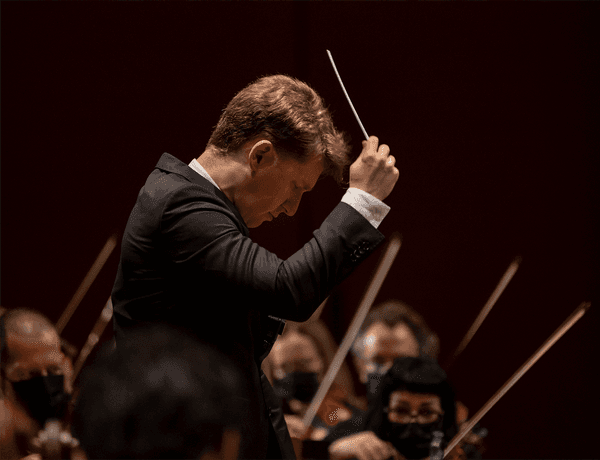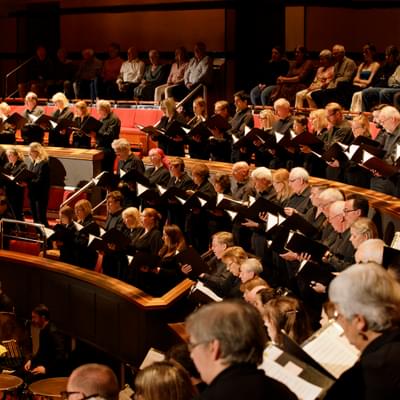New World Symphony

Full programme
- Haas, Study for Strings (7mins)
- Bernstein, Chichester Psalms (20mins)
- Shaw, Music in Common Time (12mins)
- Dvořák, Symphony No.9 (New World) (42mins)
Performers

Joshua Weilerstein
Conductor
Michael Mulroy
Soprano
CBSO Chorus
Introduction
I’ve been looking forward to this programme for over a year, as it seems to me to be one of the most tightly knit programmes I’ve done in a while.
There are myriad connections, both historical and musical, throughout this evening. We have two Czech composers, two American composers, two Jewish composers, two choral pieces, and two beloved names of the past and two names who might be new to you.
All of these pieces also represent some sort of duality, whether it is Pavel Haas somehow finding a way to write a joyous piece of music while interned in a concentration camp, Bernstein writing in Hebrew in a piece commissioned by a Church, or Caroline Shaw writing a choral piece that is almost completely wordless.
This all culminates in a piece that represents the ultimate duality - Dvořák’s homesick love letter to Bohemian music that also incorporates the American folk music that he fell in love with during his time in the United States. Though the influence of Black American and Native American folk music (and folk tales) is impossible to miss in Dvořák’s New World Symphony, there are also many moments where one cannot distinguish between an American folk song or a Bohemian one.
Throughout this programme disparate elements live together in harmony and beauty, and so I think if there was a way to sum up this concert, it would be with how Bernstein ends his Chichester Psalms. Taking from verse 1 of Psalm 133, Bernstein has an a cappella chorus give us a supremely soft plea for brotherhood and togetherness:
Behold how good,
And how pleasant it is,
For brethren to dwell
Together in unity.
Joshua Weilerstein
Programme Notes
Pavel Haas, Study for Strings
There are often debates as to whether music can be separated from the circumstances of its composition and simply exist as music. The debate is meaningless, though, in some cases. If you listen to Haas’ Study for Strings without knowing its context, and then again with that knowledge, they are two entirely different pieces. The Jewish Czech composer Pavel Haas was sent to Theresienstadt concentration camp in1941 where he composed the Study for Strings two years later. The camp, known as a ‘waystation’ on the way to the death camps, was ‘beautified’ by the Nazis in advance of a Red Cross visit in 1944, with cleaned up barracks, a school, and an encouragement of cultural activities. Footage supposedly exists of Haas taking a bow after a camp performance of Study for Strings.
It is hard to imagine how such vibrant music can be written in these circumstances, but Polish composer Viktor Ullmann, who was killed in Auschwitz, said that ‘there is a secret law that forces creative people to create.’ The piece begins and ends with great fizz and energy, with an almost jaunty folk-like melody at the start. In between are passages in a busy ‘canon’, and a slower, more melancholy section. So far, so conventional for a brief string piece. Yet the darker, edgier elements of the work – the increasingly discordant canon, and particularly the sombre slow passage - take on a powerful and painful significance with the knowledge of the work’s context. In 1944 the prisoners were sent to Auschwitz, and Haas was killed in the gas chambers. The orchestral parts of Study for Strings were retrieved from Theresienstadt after the war by conductor Karel Ančerl, a fellow Theresienstadt/Auschwitz detainee, who survived the Holocaust.
Leonard Bernstein, Chichester Psalms
I. Psalm 108: 2, Psalm 100
II. Psalm 23. Psalm 2: 1-4
III. Psalm 131, Psalm 133: 1
Bernstein’s Chichester Psalms was commissioned by the Reverend Walter Hussey, Dean of Chichester Cathedral, looking for a light choral work ‘perhaps with a touch of West Side Story!’. Bernstein, in a brief sabbatical from teaching and conducting, enthusiastically seized the commission and set Hebrew translations of four psalms for treble solo and chorus with orchestra, describing the finished work as ‘the most accessible, B-flat majorish tonal piece I have ever written’.
For much of the piece, the music is festive indeed, opening with an initial challenge from the timpani and full chorus to ‘arise and wake’. This is followed by a boisterous setting of Psalm 100 (‘Make a joyful noise’) in a playful seven beats to a bar, including some intriguing percussion effects towards the end of the section. The volume is turned right down for the secondmovement, a setting of ‘The Lord is my Shepherd’ for treble solo accompanied only by harp (used to beautifully poignant effect in the final, wordless shot of Bradley Cooper’s 2023 biopic of Bernstein, Maestro). The sopranos join in, in similarly gentle fashion, but are overtaken by a raucous shout from the male singers, forcefully declaiming Psalm 2: ‘Why do the nations rage?’. The treble rejoins, restoring peace and calm. Bernstein thriftily recycled some of the music in this movement from an unachieved opera project (there is also a touch of the Bernstein’s film score On the Waterfront in the solo line), and the men’s chorus from a passage discarded from West Side Story. Psalm 131 begins with a sombre instrumental prelude, but the agitation is calmed by the men’s voices, who arrive with an undulating chorale. A reflective string quartet emerges from the texture towards the end, joined by solo voices. The finale emerges from the last chord of Psalm 131 – a serene and hushed setting of Psalm 133.
Caroline Shaw, Music in Common Time
Shaw’s Music in Common Time manages to be startlingly original, yet at the same time deliver a kind of montage of Americana from the last century. The distinctive rising fifth from the opening passage seems to echo Aaron Coplands Fanfare for the Common Man, while the achingly sweet song in the final section (beginning ‘Years ago/I forget’) sounds as if it has been unearthed from a nineteenth century Midwest hearthside. The piece, with its often wordless chorus, revolves mainly around a conventional D major chord yet embarks on frequent adventures away from its centre – as Shaw puts it, it settles into a ‘darker harmonic world’. Around halfway through, a rising figure – sounding initially like a noble chorale – swims in and out of the texture, sometimes joined, sometimes attacked, sometimes subverted by the chorus. The choir occasionally seems as if it’s inhabiting an entirely different temporal and musical plane, with surprising sonic events such as ‘throat singing,’ a raspy, eerie vocal technique, followed by the string sound dismantling itself into prickly pizzicato. The concluding ‘Years ago’ follows, and while initially sounding deeply conventional, we find it has the same agenda of fragmentation heard so far. Shaw rightly suggests that Music in Common Time ‘pivots towards and away from expectation’.
Antonin Dvořák, Symphony No.9 (From the New World)
Dvořák arrived in the ‘New World’ in 1892 having been appointed Director of the National Conservatory of Music. As a composer steeped in the traditional music of his own country, he was keen to explore what folk music the US had to offer, yet found to his surprise that most American composers largely looked to Europe for their influence., For his ‘New World’ Symphony, Dvořák turned instead to American Indian and Black musicians, in the latter case inviting a Black National Conservatory student Harry Burleigh to sing to him. The numerous, memorable folk-like melodies in the Symphony are not, it would seem, actual folk songs but created in their style – the famous cor anglais melody of the second movement, for example, sounds like a spiritual.
The Symphony begins unobtrusively, for a few bars at least, until the first punchy rhythm blasts out of the orchestra: a call and response between strings, timpani and wind. Shortly after the dominating theme of the first movement rises from the horns and low strings. Further themes come and go, notably one introduced by the flute – somewhat resembling ‘Swing Low, Sweet Chariot,’ and easily imaginable as the soundtrack to a homely scene in a Western. While the first movement ends with a bang, the second opens with a solemn brass chorale. It is lining up the Symphony’s most famous tune – for some, inextricably linked to Yorkshire and Hovis bread (from the 1970s advertisement). Dvořák reportedly changed the soloist from clarinet to cor anglais as the latter sounded more like Harry Burleigh’s voice. The central section is lighter, if somewhat jittery, before coming ‘home’ to the cor anglais theme, and closing with the chorale.
In the Scherzo, Dvořák seems more drawn to his homeland, with Bohemian-inspired, dance-like melodies. The string section does much of the rhythmic including a shadowy reference to the main theme of the first movement. The finale initially resembles the theme tune to Jaws, but quickly moves to an assertive melody in the brass, followed by a kind of hoedown in the strings. Even more than the other three movements, this has a breathless succession of motifs and moods – many of which are throwbacks to previous movements - generously distributed across the entire orchestra. Some sections gallop furiously, others slow down to dwell in a more bucolic sounding landscape. In the final bars there is a gloriously discordant version of the first movement’s theme before an ebullient close.
Programme Notes (c) Lucy Walker
Featured image © Yuri Pires Tavares